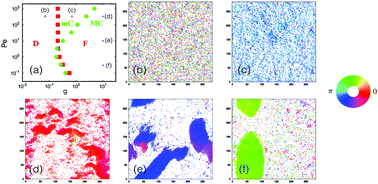当前位置:
X-MOL 学术
›
Soft Matter
›
论文详情
Our official English website, www.x-mol.net, welcomes your
feedback! (Note: you will need to create a separate account there.)
Collective motion of active Brownian particles with polar alignment†
Soft Matter ( IF 2.9 ) Pub Date : 2018-03-16 00:00:00 , DOI: 10.1039/c8sm00020d Aitor Martín-Gómez 1, 2, 3 , Demian Levis 4, 5, 6, 7, 8 , Albert Díaz-Guilera 7, 8, 9, 10, 11 , Ignacio Pagonabarraga 4, 5, 6, 7, 8
Soft Matter ( IF 2.9 ) Pub Date : 2018-03-16 00:00:00 , DOI: 10.1039/c8sm00020d Aitor Martín-Gómez 1, 2, 3 , Demian Levis 4, 5, 6, 7, 8 , Albert Díaz-Guilera 7, 8, 9, 10, 11 , Ignacio Pagonabarraga 4, 5, 6, 7, 8
Affiliation

|
We present a comprehensive computational study of the collective behavior emerging from the competition between self-propulsion, excluded volume interactions and velocity-alignment in a two-dimensional model of active particles. We consider an extension of the active brownian particles model where the self-propulsion direction of the particles aligns with the one of their neighbors. We analyze the onset of collective motion (flocking) in a low-density regime (10% surface area) and show that it is mainly controlled by the strength of velocity-alignment interactions: the competition between self-propulsion and crowding effects plays a minor role in the emergence of flocking. However, above the flocking threshold, the system presents a richer pattern formation scenario than analogous models without alignment interactions (active brownian particles) or excluded volume effects (Vicsek-like models). Depending on the parameter regime, the structure of the system is characterized by either a broad distribution of finite-sized polar clusters or the presence of an amorphous, highly fluctuating, large-scale traveling structure which can take a lane-like or band-like form (and usually a hybrid structure which is halfway in between both). We establish a phase diagram that summarizes collective behavior of polar active brownian particles and propose a generic mechanism to describe the complexity of the large-scale structures observed in systems of repulsive self-propelled particles.
中文翻译:

极性对齐的活动布朗粒子的集体运动†
我们提出了一种综合的计算研究,该研究是在活性粒子的二维模型中,从自我推进,排除的体积相互作用和速度排列之间的竞争中产生的集体行为而得出的。我们考虑了活动布朗粒子模型的扩展,其中粒子的自推进方向与其邻居之一对齐。我们分析了低密度状态(表面积为10%)中集体运动(植绒)的发作,并表明它主要受速度对准相互作用的强度控制:自推进和拥挤效应之间的竞争较小植绒作用的出现。但是,在植绒门槛以上,与没有对准相互作用(活性布朗粒子)或排除体积效应(类似Vicsek的模型)的类似模型相比,该系统提供了更丰富的图案形成场景。取决于参数范围,系统的结构的特征是有限大小的极性簇的广泛分布,或者存在无定形,高度波动的大规模行进结构,该行进结构可能呈车道状或带状形式(通常是介于两者之间的混合结构)。我们建立了一个相图,总结了极性活性布朗粒子的集体行为,并提出了一种通用机制来描述在斥力自推进粒子系统中观察到的大规模结构的复杂性。系统的结构的特征是有限范围的极性簇的广泛分布,或者存在无定形的,高度波动的大规模行进结构,该行进结构可以呈车道状或带状(通常是混合动力)。介于两者之间的中间结构)。我们建立了一个相图,总结了极性活性布朗粒子的集体行为,并提出了一种通用机制来描述在斥力自推进粒子系统中观察到的大规模结构的复杂性。系统的结构的特征是有限范围的极性簇的广泛分布,或者存在无定形的,高度波动的大规模行进结构,该行进结构可以呈车道状或带状(通常是混合动力)。介于两者之间的中间结构)。我们建立了一个相图,总结了极性活性布朗粒子的集体行为,并提出了一种通用机制来描述在斥力自推进粒子系统中观察到的大规模结构的复杂性。
更新日期:2018-03-16
中文翻译:

极性对齐的活动布朗粒子的集体运动†
我们提出了一种综合的计算研究,该研究是在活性粒子的二维模型中,从自我推进,排除的体积相互作用和速度排列之间的竞争中产生的集体行为而得出的。我们考虑了活动布朗粒子模型的扩展,其中粒子的自推进方向与其邻居之一对齐。我们分析了低密度状态(表面积为10%)中集体运动(植绒)的发作,并表明它主要受速度对准相互作用的强度控制:自推进和拥挤效应之间的竞争较小植绒作用的出现。但是,在植绒门槛以上,与没有对准相互作用(活性布朗粒子)或排除体积效应(类似Vicsek的模型)的类似模型相比,该系统提供了更丰富的图案形成场景。取决于参数范围,系统的结构的特征是有限大小的极性簇的广泛分布,或者存在无定形,高度波动的大规模行进结构,该行进结构可能呈车道状或带状形式(通常是介于两者之间的混合结构)。我们建立了一个相图,总结了极性活性布朗粒子的集体行为,并提出了一种通用机制来描述在斥力自推进粒子系统中观察到的大规模结构的复杂性。系统的结构的特征是有限范围的极性簇的广泛分布,或者存在无定形的,高度波动的大规模行进结构,该行进结构可以呈车道状或带状(通常是混合动力)。介于两者之间的中间结构)。我们建立了一个相图,总结了极性活性布朗粒子的集体行为,并提出了一种通用机制来描述在斥力自推进粒子系统中观察到的大规模结构的复杂性。系统的结构的特征是有限范围的极性簇的广泛分布,或者存在无定形的,高度波动的大规模行进结构,该行进结构可以呈车道状或带状(通常是混合动力)。介于两者之间的中间结构)。我们建立了一个相图,总结了极性活性布朗粒子的集体行为,并提出了一种通用机制来描述在斥力自推进粒子系统中观察到的大规模结构的复杂性。











































 京公网安备 11010802027423号
京公网安备 11010802027423号